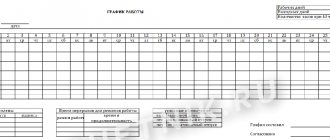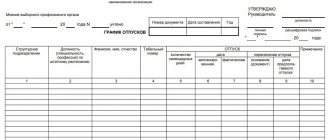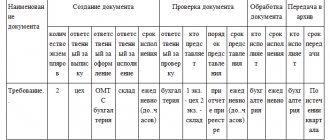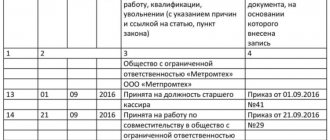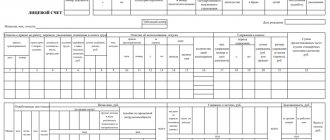Work in the “every three days” mode can be introduced by the employer’s decision based on the specifics of the company’s activities. The work schedule in this case helps to streamline the work of employees and distribute working days and rest periods taking into account the standard working hours, as well as calculate overtime. How to create such a schedule? Who should not be included in it? How to pay for work according to the schedule in three days? The answers to these and other questions are in our material. Here you will find a sample work schedule every three days.
Who should not be included in the work schedule every three days
The work schedule “in three days” cannot include workers who are subject to prohibitions and restrictions established by labor legislation:
- a ban on working on the night shift (for example, for pregnant employees under Part 5 of Article 96, Part 1 of Article 259 of the Labor Code of the Russian Federation);
- limitation on the duration of daily work (for example, for minor employees under Article 94 of the Labor Code of the Russian Federation).
Useful information from ConsultantPlus
In the materials of the legal reference system you will find the necessary tips:
– What are the features of the working hours of a minor worker; – Guarantees for pregnant women at work.
How to correctly create a work schedule every three days
The schedule is drawn up as a separate document. It has three important functions:
- control: the schedule helps to track the standard working hours for each employee;
- informative: from the schedule, employees learn about work shifts and rest days, the start/end of working hours and rest time;
- coordinating: using the schedule, the work of employees is regulated;
It is better to draw up a schedule for the entire accounting period at once.
The schedule usually indicates:
- the period for which it was compiled;
- Full name and position of employees;
- distribution of working days during the month;
- other necessary information at the discretion of the employer.
The work schedule “in three days” might look like this:
Sample schedule of a day in three
We comply with the standard working hours when drawing up a schedule every three days
The first thing an employer needs to pay attention to when drawing up a work schedule is compliance with standard working hours.
The work schedule “in three days” does not allow the employer to comply with the requirement of Art. 91 of the Labor Code of the Russian Federation to the normal working hours, which is no more than 40 hours per week. This problem can be solved by introducing summarized working time recording for such employees (Part 1 of Article 104 of the Labor Code of the Russian Federation).
In case of summarized accounting, the duration of working hours for the accounting period (month, quarter or other periods) should not exceed the normal number of working hours.
Summarized recording of working hours allows the number of actually worked hours in one day or one week to exceed the norm. This excess is compensated by reducing the number of working hours during other days or weeks within the reference period.
The duration of the accounting period is determined by the employer. By law, it cannot exceed:
- 3 months - to record the working time of employees engaged in work with harmful and (or) dangerous working conditions;
- one year for other employees.
The employer needs to monitor compliance with working hours twice: at the stage of drawing up the schedule and at the end of the accounting period. This is due to the fact that some periods reduce the standard working time (annual paid holidays, periods of temporary disability, business trips).
What is shift work and what are the restrictions?
If you understand what a shift schedule of 12 hours or another duration is, then this is a work and rest schedule that alternates in a certain way during a month or other accounting period. When drawing it up, the employer is obliged to comply with labor laws and ensure compliance with a number of conditions. First of all, it is necessary to keep a summary record of working time and monitor that the limits for enlarged periods (month or quarter) are observed.
If, due to production needs, it is necessary to introduce a continuous work schedule of 12 hours or another schedule for employees, then comply with the following requirements:
- the maximum possible duration of a shift (according to Article 94 of the Labor Code of the Russian Federation);
- the minimum time for weekly continuous rest is 42 hours (according to Article 110 of the Labor Code of the Russian Federation);
- definition of night shift - from 22:00 to 06:00;
- Certain categories of workers cannot be recruited to work at night and on shifts.
Article 102 of the Labor Code of the Russian Federation indicates the need for agreement between the employer and workers on the start and end times and the total duration of work. If the organization has a trade union, then its opinion should be taken into account when drawing up the schedule.
Art. 103 of the Labor Code of the Russian Federation says that it is impossible to oblige an employee to work two shifts in a row.
The shift should not exceed the duration limits established by Article 94 of the Labor Code of the Russian Federation. For different categories of employees, when calculating the shift schedule, take into account how much they are allowed to work.
| Category of workers | Time |
| 14–16 year olds combining work and study | 2.5 hours |
| 4 hours |
| 15–16 year olds during the holidays | 5 o'clock |
| When working a week of less than 30 hours in harmful or dangerous conditions | 6 hours |
| 16–18 year olds during holidays | 7 o'clock |
| Working a 36-hour workweek in hazardous or hazardous conditions | 8 ocloc'k |
For other categories, the indicator is calculated based on a norm equal to a forty-hour work week.
Breaks in work when scheduled every three days
The second important nuance is the competent organization of the employee’s work. During working hours, he is entitled to food breaks and other regulated periods of rest, since without this, for 24 hours in a row, it is difficult for an employee to perform labor functions effectively and fully.
Labor legislation also provided for this nuance, stipulating the employer’s obligation to provide the employee with breaks for rest and food during the working day. This period of time is limited: no less than 30 minutes and no more than two hours per working day. These breaks are not included in working hours (Article 108 of the Labor Code of the Russian Federation)
Time restrictions provided for in Art. 108 of the Labor Code of the Russian Federation, every employer is obliged to comply. The specific duration of breaks and the time they are provided within 24 working hours are prescribed in the PVTR. For example, you can set two breaks of 60 minutes, four breaks of 30 minutes, or some other combination of number and duration.
If, due to production (work) conditions, it is impossible to provide a break, the employer is obliged to provide the employee with the opportunity to rest and eat food during working hours (Article 108 of the Labor Code of the Russian Federation). A list of such work, as well as places for rest and eating are established in the PVTR.
Taking into account the above, with a work schedule of “every three days”, the employee’s time sheet may show either 24 hours (in a situation where there are no breaks excluded from working time due to working conditions) or a shorter period of time (for example, 22 hours, when the employee can be absent from work). places and two-hour breaks will not be included in working hours).
Duration of work
Working in shifts does not mean that an employee must perform his job functions for all 12 or 24 hours in a row. Do not confuse the concepts of total time spent at the workplace and the concept of direct work time.
The total time spent at work is the time that an employee spends from the moment he arrives at the workplace until the moment he goes home during the inter-shift rest period. This includes all hours, including those allocated for rest, meals, personal needs and other activities not related to his direct work.
Direct work time is the time when an employee performed the functions assigned by job or work instructions. Essentially, these are all useful actions of the employee, based on which the company should ultimately make a profit.
Typically, the actual duration of work of employees is determined based on the following criteria:
- Company operating technologies. This takes into account what equipment should work and how, or what services should be provided and at what time.
- Dedicated financial resource for wages. Based on it, you can calculate how many employees the company can hire to fulfill its obligations.
- Legislative restrictions. In this block, it is necessary to take into account the physiological characteristics of the human body, labor protection requirements, and industrial sanitation standards.
- Duration of working hours for a specific category of employees working in these working conditions.
- All periods of additional legal rest or absence from work. This point applies to employee vacations, as well as paid sick leave.
Remember, in order to correctly calculate the duration of work for each specific employee, it is necessary to take into account all production factors, as well as take average calculated data on legal absences to be able to predict the personnel reserve.
Taking into account all the above factors, shift schedules are drawn up. They are done separately for each division. Changes to this document are made in the same manner as it was compiled.
With whom to agree on the schedule and when to familiarize employees with it
According to the general rules, work schedules must be coordinated with the trade union body and employees must be familiarized with it against signature no less than 30 days before the schedule comes into effect.
However, for the “in three days” schedule, these requirements are not applicable. Coordination with the trade union and written familiarization with the schedule at least 30 days in advance are required when drawing up a shift schedule - when employees work in two, three or four shifts and replace each other at the workplace during the day (Article 103 of the Labor Code of the Russian Federation).
With a “every three days” schedule, no one replaces the employee during the working day, that is, work in this mode is not considered shift work. This means that the employer has no obligation to agree on the schedule and comply with the deadlines for familiarizing employees with it. Although it is in the employer’s interests to comply with these requirements.
The employer has the right to set the period for familiarization of employees with the “every three days” schedule at its discretion, recording it in the PVTR or other local act. This will help to promptly resolve issues related to their workload with employees and avoid unnecessary proceedings.
What should be in the shift schedule
Mandatory items in the shift schedule
Now a little about the specific standards that should be provided for in shift schedules. The legislator does not establish a clear, uniform form of schedules for different companies. This is not surprising - each enterprise has its own characteristics, and averaging something for everyone will not always be acceptable in each specific case.
At the same time, certain positions must appear in each chart, namely:
- full data of employees involved in shift work (full name, position, department);
- when the work shift begins and ends (indicated opposite the last name of each employee);
- time for rest and eating (usually it is common to all shifts and is included in the notes under the schedule);
- the order in which employees start working in shifts (it is optimal if all this is on one large chart, so that all employees have the opportunity to become familiar with the fair distribution of powers);
- the total number of employees who take over a shift (also optimal if everything is laid out on one schedule and workers independently have the opportunity to determine how they work);
- columns for personal signatures of employees (in order to avoid further conflict situations, the employer is obliged to familiarize employees in advance with their future work schedule against signature);
- The schedule must necessarily be approved by the manager, as well as agreed upon with trade unions.
Remember, the proposed list includes only basic points, without which it is difficult to determine who will work and how, as well as to relieve the tense situation regarding the fair distribution of work in the team. The employer has the right to supplement it taking into account local circumstances.
What to include in employment contracts and PVTR when introducing a schedule in three days
An employer cannot limit itself to just drawing up a work schedule “in three days.” The law requires adjustments to be made to the company’s local regulations and employment contracts with employees if such a regime is being introduced in the company for the first time.
The procedure for introducing summarized recording of working time is prescribed in the internal labor regulations (Part 4 of Article 104 of the Labor Code of the Russian Federation). If summarized accounting is introduced in a company for the first time, the employees affected by this must be notified in writing at least two months before the introduction of this form of accounting (Article 74 of the Labor Code of the Russian Federation).
The specifics of the work regime of employees hired to work every three days must be specified in employment contracts (Article 57 of the Labor Code of the Russian Federation). In particular, it needs to reflect (paragraph 6, part 2, article 57, part 1, article 100 of the Labor Code of the Russian Federation):
- length of the working week (working week with days off on a rotating schedule);
- the order of alternating working days and weekends (determined by the work schedule).
- duration of daily work, start and end times of work, time and duration of breaks in work;
- accounting period, if summarized accounting of working time is introduced (part 1.2 of article 104 of the Labor Code of the Russian Federation)
Template for wording in an employment contract:
If the employer belongs to micro-enterprises and has refused to adopt local regulations (including work schedules), all the necessary features of the “every three days” work schedule should be specified in the employment contract according to the standard form (Parts 1, 2 of Article 309.1, Art. 309.2 Labor Code of the Russian Federation).
Number of shifts and workers in them
If we talk about the time period of one shift, then the range of options ranges from 3 to 12 hours in one day. The number of shifts is set by the management of the enterprise and is determined by the specifics of the production process and the degree of workload. Shifts are used year-round or seasonally - during periods of increased demand for certain products. Social services operate in this mode all year round.
Read more: Work schedule in the organization
The number of workers on each duty is not limited. If you decide to draw up a schedule for 3 people, so that 2 are in a shift, or according to another principle, then be sure to take into account the opinion of the trade union (if any) and draw up the document as an appendix to the collective agreement.
The updated work schedule (Article 103 of the Labor Code of the Russian Federation) is brought to the attention of each employee at least a month before implementation. The Labor Code categorically prohibits assigning two or more shifts in a row to the same group of workers.
ConsultantPlus experts discussed how an employer can make changes to the shift schedule. Use these instructions for free.
How to pay for work according to a schedule in three days
Payments to an employee working in the “every three days” mode include:
- payment for hours worked;
- additional payment for night work;
- payment for work on non-working holidays;
- overtime pay;
- payment for hours lost due to the fault of the employer.
Night work is work in the period from 22.00 to 6.00 (Article 96 of the Labor Code of the Russian Federation), each hour of which the law requires payment at an increased rate (Article 154 of the Labor Code of the Russian Federation). The minimum additional payment for night work is 20% of the hourly tariff rate (salary) for each hour worked (Resolution of the Government of the Russian Federation of July 22, 2008 No. 554). The specific amounts of the “night” supplement are established by a collective agreement, local regulation or employment contract.
, work on a weekend or a non-working holiday is paid at least double (Article 153 of the Labor Code of the Russian Federation). For the “in three days” schedule, you need to take into account the following nuance: if according to the schedule the working day falls on a regular day off (for example, Sunday), the salary is accrued in a single order, but if the employee goes to work on Sunday not according to his schedule at the request of the employer, this day must be paid at an increased rate.
Overtime is calculated and paid at the end of the accounting period, if it is planned - when the schedule could not be drawn up within the normal working hours. Work on holidays performed in excess of normal working hours is not taken into account in the calculation of overtime, since it is already paid double (clause 4 of Explanation No. 13/P-21 “On compensation for work on holidays”, approved by the Resolution of the State Labor Committee USSR, Presidium of the All-Union Central Council of Trade Unions dated 08.08.1966 No. 465/P-21).
Unplanned overtime, when work beyond the norm is initiated by the employer (in the cases specified in Article 99 of the Labor Code of the Russian Federation), is paid immediately at the end of the month.
Specific amounts of payment for overtime work are prescribed in a collective agreement, local regulation or employment contract. At the request of the employee, overtime work can be compensated for by an additional day of rest instead of increased pay.
Hours of deficiency according to the “every three days” schedule are determined based on the results of the accounting period. The employer is to blame for the shortfall in work, having not worked the employee to the full standard of hours, so the hours of shortfall must be paid in an amount not lower than the average salary of the employee, calculated in proportion to the actual time worked (Part 2 of Article 22, Part 1 of Article 155 of the Labor Code of the Russian Federation, p. 13 Regulations approved by Decree of the Government of the Russian Federation dated December 24, 2007 No. 922).
Is the daily schedule considered shift work?
The daily schedule can be established not only during shift work, but also in the flexible schedule mode provided for in Art. 102 Labor Code of the Russian Federation. How they differ - see the table below.
| Criteria | Shift work | Flexible working hours |
| How to make a schedule | By the employer with the approval of the trade union, etc. | By agreement of the parties |
| Is it possible to assign an employee to 2 shifts in a row? | It is forbidden | Possible, with the consent of the employee |
| What does overtime consist of? | From the hours of work after the shift within Art. 99 of the Labor Code of the Russian Federation + in excess of the norm established for the accounting period | Hours in excess of the norm established for the accounting period |
| Is summarized working time recording introduced? | Necessarily | Necessarily |
| Is a night shift reduced by an hour? | Reduced | Doesn't shrink |
| How are shifts that fall on a holiday paid? | At least double the size | At least double the size |
| Who should not be placed for a day | Pregnant women, minors, disabled people with children under 3 years old, etc. | |
Note! Regardless of the type of regime in force at the enterprise, the employee retains his labor rights and guarantees. For example, if an employee fails to show up for work for valid reasons (sick leave, etc.), he is not required to work the missed shift. Of course, all other guarantees provided for by the Labor Code of the Russian Federation are also preserved (the right to annual paid leave, due to a reduction in compensation and payments, etc.)
How will an employer be punished for miscalculations with the schedule and organization of work on a 24/7 schedule?
An employer who violates labor laws will face a warning or an administrative fine (Part 1 of Article 5.27 of the Code of Administrative Offenses of the Russian Federation):
- for individual entrepreneurs and officials - from 1,000 to 5,000 rubles;
- for companies - from 30,000 to 50,000 rubles.
For example, such liability awaits an employer who introduced the “every three days” work schedule in accordance with Art. 74 of the Labor Code of the Russian Federation, but did not notify employees of the changes at least two months in advance.
If the employment contracts with employees do not specify in detail the working hours when it is individual for the employee, and are not recorded in the PVTR, liability will arise under Parts 4, 5 of Art. 5.27 Code of Administrative Offenses of the Russian Federation. Amounts of fines under this article:
- for individual entrepreneurs - from 5,000 to 40,000 rubles.
- for companies - from 50,000 to 200,000 rubles,
- for officials - from 10,000 to 20,000, and in some cases the manager faces disqualification for up to 3 years.
Let's sum it up
- The work schedule “in three days” is drawn up as a separate document, which employees are introduced to upon signature.
- It cannot include employees who are subject to prohibitions and restrictions provided for by labor legislation (pregnant employees, minors, etc.);
- All schedule parameters (length of the working day, start and end times of work, time and duration of regulated breaks) must be specified in the PVTR, local acts or employment contracts.
- For failures in organizing work according to the “every three days” schedule, the company faces fines, and the manager can be disqualified for up to three years.
When does a shift work schedule apply?
A shift schedule is a fairly common phenomenon. It is used in a wide variety of industries, most often in companies with a continuous round-the-clock production cycle - the need for its use here is due to the fact that equipment downtime is unacceptable, because they lead to system failures and significant financial losses. But regular, timely replacement of personnel leads to an increase in the volume of output, improved labor productivity and, as a result, greater profits.
Also, a shift schedule is common in other areas, for example, in medical institutions, security structures, firefighters, gas services, rail and transport transportation, air travel, etc.
